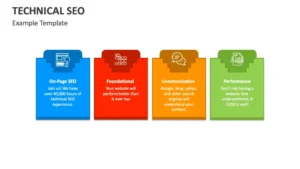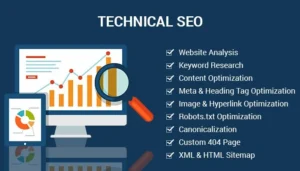Technical SEO Essentials: Optimize Your Site for Success

Step-by-Step Guide to Optimizing Technical SEO for Better Rankings
Introduction:- Website optimization to make it search engine-friendly has always played an important role in the digital world. We can state that Technical SEO serves as the foundational component of SEO, enhancing the technical aspects of a website to increase its visibility in the SERPs. While on-page SEO targets content optimization and off-page SEO focuses on external linking, this SEO focuses on the structural elements that influence how search engines crawl and index a website.

What is Technical SEO?
Technical SEO involves optimizing the site’s technical side to improve its performance, security, and user experience. It includes practices designed to ensure search engines can easily access, crawl, and index your website to achieve organic rankings. The technical aspects of SEO involve site speed, mobile-friendliness, secure connections, structured data, and more.
Technical SEO provides the foundation upon which we build a website. A basic technical setup allows search engines to correctly understand the website’s content and lets users navigate the site with ease.
Types of Technical SEO
Various technical SEO practices target different aspects of website optimization.
1. Site Speed Optimization
Page speed acts as another ranking factor. This SEO employs methods to decrease loading time by optimizing image sizes, leveraging browser cache, and minimizing JavaScript and CSS files. A faster site enhances user experience by reducing bounce rates.
2. Mobile-Friendliness
With Google’s mobile-first indexing, your site must be mobile-friendly. Implementing this SEO involves ensuring the website works well on mobile devices with responsive design and modifying the layout based on view size.
3. SSL & HTTPS Security
This ranking factor involves enabling a secure HTTPS connection that encrypts data between the user’s browser and the server with sensitive information. This SEO includes setting up SSL to improve trustworthiness and security.
4. Structured Data & Schema Markup
Schema markup simplifies search engines’ understanding of a page’s content. Adding structured data boosts the chance of obtaining rich snippets and high-end features, like knowledge panels.
5. XML Sitemap Optimization
An XML sitemap lists all vital pages on a website, helping search engines find and crawl them better. This SEO involves creating and optimizing this sitemap to accurately represent the website’s structure.
6. File Optimization of the Robots.txt File
The robots.txt file specifies pages for search engines to crawl or not. Optimizing this file prevents duplicate content problems and ensures search engines focus on the most important website content.
7. Canonical Tags
Canonical tags prevent duplicated content by indicating the preferred variant of a web page when several URLs refer to the same thing. This SEO ensures the proper placement of canonical tags to maintain a clean site structure.
8. Optimization of URL Structure
Clean and descriptive URLs benefit search engines and users alike. Technical SEO structures URLs to reflect the page’s name and concepts, enhancing both indexing and user comprehension.

Benefits of Technical SEO
Technical SEO offers many advantages in improving website functionality and visibility.
Better Search Engine Rankings
Technical optimization makes the website more accessible to search engines, increasing the chances of higher rankings. It enables search engines to better crawl, understand, and rank optimized sites.
Improved User Experience
- Technical SEO practices, like speeding up the site, enhancing mobile-friendliness, and ensuring security, all enhance user experience. Satisfied visitors engage more and return frequently, leading to improved conversions and reduced bounce rates.
- A faster website provides significant benefits. This SEO facilitates faster loading through processes like compressing images, minification of files, and enabling browser caching. Faster websites retain users and reduce bounce rates.
Accurate Indexing
Technical SEO includes installing XML sitemaps and optimizing Robots.txt files to ensure all crucial site pages index correctly on search engine results pages, reducing inaccurate indexing.
Better Security and Trustworthiness
SSL/HTTPS protocols signal to visitors that the website is secure, enhancing trust and credibility. Security impacts search engine rankings and secure websites generally rank higher.
Rich Snippet
Adding structured data can lead to rich snippets in search results, like product prices, reviews, and images. Snippets increase click-through rates and bring more traffic.
Reduced Duplicate Content
Technical SEO addresses duplicate content issues using canonical tags, URL structures, and robots.txt files, preventing redundancy and saving search engines time on low-value pages.

Why Do We Need Technical SEO?
Technical SEO acts as the backbone of a website’s success in search engines. Without it, even the most engaging content and effective link-building may fail.
- Foundations for Other SEO Types: On-page and off-page SEO rely on a solid technical foundation. Without it, content and backlinks have no value to search engines, as they can’t crawl and index the website.
- Adaptability to Algorithm Updates: Search engines, especially Google, update algorithms to Favor fast, secure, and mobile-friendly sites. A website optimized with this SEO adapts to these changes, reducing the risk of rankings dropping.
- Scalability for Future Growth: Technical SEO prepares the website for future growth. As websites grow, this SEO ensures performance remains robust while managing more content, new pages, and increased traffic.
- Competition: In competitive industries, minor differences in speed, security, and design can impact rankings. Technical SEO keeps your website aligned with search algorithm demands.

How Technical SEO Works
Technical SEO involves various practices to optimize a website’s core.
- Audit and Analysis: A comprehensive technical SEO audit determines existing features. Tools like Google Search Console, Ahrefs, and SEMrush diagnose page speed issues, crawl errors, and security gaps.
- Implementation of Best Practices: Best practices involve mobile responsiveness, connection security protocols, structured data, and canonical tag use. This SEO demands constant monitoring to remain optimized, using tools like Google Page Speed Insights and GTmetrix.
- Regular Updates: SEO best practices evolve with search engine algorithm changes. Regular updates to technical SEO ensure compliance with search engine guidelines and avoid penalties.
Conclusion
Technical SEO is crucial for a website’s search engine success. Optimizing site speed, security, structured data, and mobile friendliness ensures a site is optimized for search engines and users. It improves ranking and user experience through a secure, efficient site structure. Embracing this SEO is vital for anyone aiming to create a competitive, high-quality website that meets evolving SEO requirements.”








